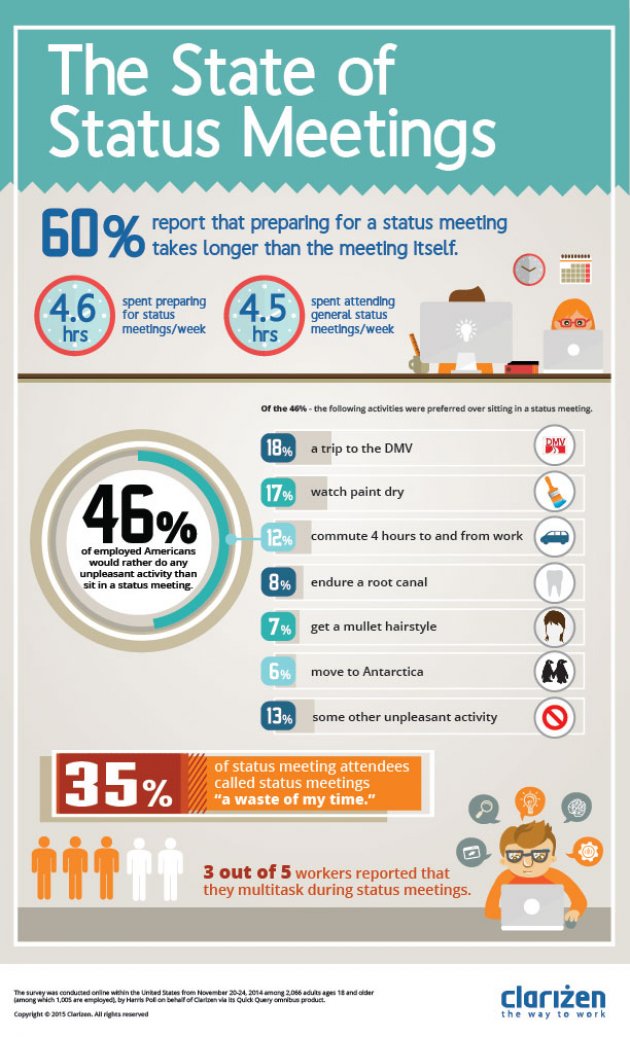They may be called “status meetings” “check-ins” “team meetings” or “updates.” You may have them once a month, once a week, once a day, or once every quarter. They all have one thing in common: Your employees hate them.
It might surprise you to learn just how much. In a recent Harris poll, sponsored by the online collaboration company Clarizen, 46 percent of respondents said they’d prefer to do almost anything else instead of sitting in a status meeting. Seventeen percent said they would choose to watch paint dry. Eight percent said they would opt for root canal.
That’s bad enough, but what’s worse is the amount of time respondents reported spending on these unloved meetings. On average, they said they spent 4 hours a week in status meetings, and 4.6 hours a week preparing for them. In other words, these meetings cost the average company one day a week of work time per employee. A company or team that eliminated them should see productivity increase by about 20 percent.
Does this mean you should ban all meetings? No, says Clarizen CEO Avinoam Nowogrodski. “Meetings have value,” he says, “but only if they are focused on problem solving, innovation, and identifying opportunities to cross-leverage each other’s work.”
And lest you be tempted to replace status meetings with email check-ins, those aren’t much better, he warns. “Status meetings, via email, physical meetings, or PowerPoint deck, kill productivity. Information workers spend countless hours gathering data, preparing and presenting about their work rather than doing their work.”
So what should you do instead?
1. Try collaboration software.
Obviously, this likely conclusion was Clarizen’s motive for sponsoring the study. That said, they have a point. Collaboration or project management software, or even a large spreadsheet mounted on the wall, would allow every member of the team to see the status of every other member’s projects whenever they wanted. That would save a lot of time over check-in meetings or having teams write up reports.
2. Meet standing up.
This increasingly popular practice doesn’t eliminate status meetings, but forces participants to keep their comments short because no one wants to spend hours on their feet. A further benefit is that standing for a few minutes will improve the health of employees who would otherwise be seated all day.
The down sides are that employees still have to spend time preparing for the meetings, so productivity gains may be lessened. Also, standing meetings require some discipline, both in not sitting, and in punctuality (because if people are waiting around for missing colleagues they’re likely to sit or resent having to stand). Still, standing status meetings are still a whole better than seated ones.
3. Do something fun instead.
Part of the purpose of the status meeting–or any meeting–is to bring the team together so they can informally exchange ideas and information, bond, and feel and behave like a cohesive unit. If you eliminate status meetings, you can create some of the same esprit de corps by bringing people together for something purely pleasurable, such as a weekly Friday pizza or bowling outing. Your team will be happier and possibly more motivated. And they’ll spend the time they’d have spent preparing reports on something that can move your business forward.
Here’s an infographic from the Harris poll:
Source: Inc




